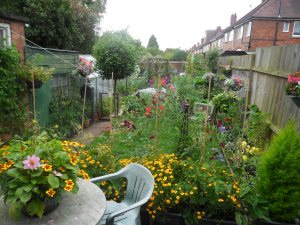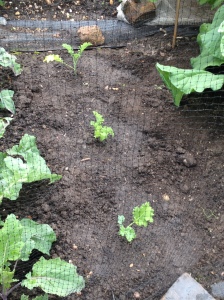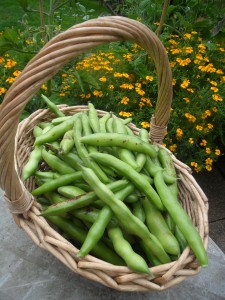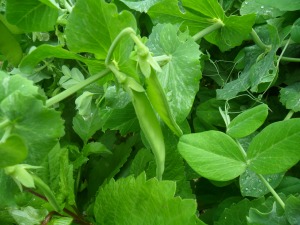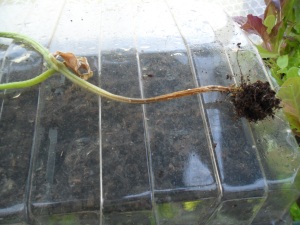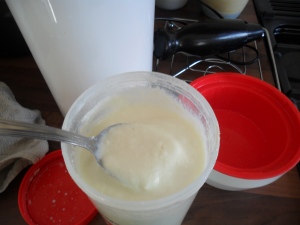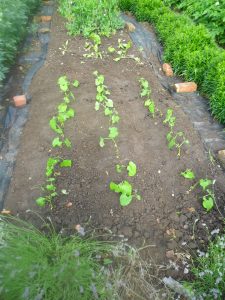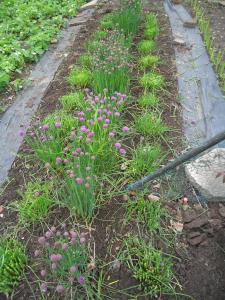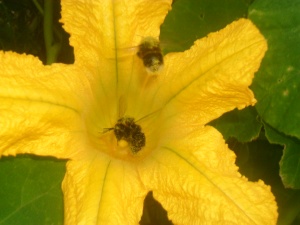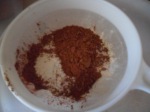This week has been another week of sunshine and showers. It has also been quite windy at times and I have had to tie up some of my peas and sweetpeas, as the wind blew them away from their supports…..though no harm was done as you can see in the photograph below:
I think nature has a way of dealing with all situations and the sunshine and showers are certainly helping my plants grow. Rain is full of nitrogen so the garden is now looking lush and green.
The sunshine and showers also produced the most spectacular rainbow in the sky (though my camera doesn’t really show the pure beauty of it as well as I would have liked).
Nature really is wonderful, but it is all too easy to take it for granted….I firmly believe that global warming is happening – every gardener has already seen the changes in the seasons – but it is so easy for us all to ignore and pretend it isn’t happening…..I know a lot of people think that it is a problem that just the goverment should be dealing with and yes I do think they should be doing more… however if we all did our own little bit e.g use our cars less, buy less ‘stuff’, recycle where possible, eat less meat, be mindful about using electricity, etc. then maybe it would make a difference.
I realise people won’t agree with me and I know how hard it is when you have children / teenagers in the house wanting ‘this’ and ‘that’, but every little bit we do (even the smallest things) will all add up.
.
This week in the garden:
.
This week I finally got around to using the extra comfrey feed that I made last year. I never got around to using it as I still had some left over from the first batch that I had made last summer.
I really expected it to stink as it had been there since last year, but amzingly it wasn’t too bad:
I strained it through and old rag and I managed to get three bottles of comfrey feed to use on my fruit and flowers around the garden, as it is so high in potash. It is particularly brilliant for tomatoes.
As my comfrey is still growing well, I started another bucket of comfrey tea off. It only takes a couple of weeks to make, though I do tend to leave it stewing until it is needed:
“To make comfrey tea all you have to do is fill a bucket with the comfrey leaves and stems and weigh it down with a brick and pour over cold water. I cover it (to stop flies getting in) and leave for approx. two weeks. Be warned, by this time the smell is revolting! Strain the comfrey tea liquid into another container and put the remaining comfrey in your compost bin.
To use it I put 2 cups of comfrey tea into a watering can and then fill it with water and give it a good mix”
.
.
This week I noticed that my runner beans were flowering and they look very pretty. However, I also noticed that they had climbed to the top of their supports, so I chopped the top of each plant off:
By nipping off the top of each plant, they will become bushier and produce more beans lower down.
.
Now that I had harvested my last spring cabbage, I decided to plant my curly kale seedlings….but first I decided to give the area a quick weed and remove the yellow leaves from the cabbages under the same net. The yellowing leaves can harbor pests and diseases so it is always a good idea to remove them every so often:
Incidentally the cabbages are growing well this year, probably to do with all the rain we have had:
After this I raked in some blood, fish and bone and then planted three curly kale plants that I had grown from seed. Hopefully if the plants grow ok then three plants will be enough for us over winter:
.
I also tied up my jeruselum artichokes as one of them had fallen down……they are planted in a bottemless deep pot, to stop them from spreading and it seems to be working:
.
Another job I finally got around to doing was to ‘prick out’ my wallflowers that I sowed a few weeks ago (they really should have been done by now).
If you look really closely at the photo on the right, you will see tiny holes on the leaves…..these holes are made by the flea beetle….
“The adult flea beetle eats the leaves of most brassica’s (including wallflowers) and their larvae will eat the plant roots.
Bad infestations can kill the plants, however this is unusual. I have found that seedlings are more suseptable to flea beatles, so if my plants come under attack I feed them regularly with a seaweed fertliser until they grow bigger and stronger.
In my experience the flea beetle will set back your seedlings, but it is very rare they don’t recover with a bit of care”
.
I also transplanted the fox gloves I sowed a month or two ago, into bigger pots to grow on:
Foxgloves (digitalis) and wall flowers are both biennial plants, which simply means they grow one year and flower the next and then die. When my plants are big enough in autumn I will plant them in the ground where they will hopefully give me a good display next year.
.
Another job I did this week was to repair a bare spot on my lawn. I raked over the area and then spread some grass seed that I had already mixed with compost. I then covered it with my heavy plastic propagator lid to protect it from Judy (our dog) and I have made sure it has been well watered.
Hopefully the grass will grow well:
.
I have also continued to tie up my outdoor tomato plants:
And I have continued to dead head all the old flowers around my garden, so they produce lots more new flowers:
.
.
This weeks harvest:
.
The strawberries are doing well considering it is their first year (I ignore the books and don’t remove the flowers the first year and I have always had good crops). I have had two harvests this week:
The courgettes have finally decided to grow and I have picked two from my two plants this week:
And I am still picking broad beans from the plants I sowed in January:
I noticed that some of the pods were suffering from ‘Chocolate spot’, but the beans were fine inside:
“Chocolate spot is a fungus that only affects broadbeans. It leaves red-brown spots on the plants and the pods. It usually affects plants in damp humid conditions, so if you have space you could put your plants further apart so air can circulate around.
In my experience chocolate spot rarely affects the beans inside the pods, so I actually ignore it and don’t do anything except give the plants a liquid seaweed feed to help them along”
I froze my broad beans to use over the winter when there isn’t too much around. I always blanch them and then open freeze them on a tray until they are frozen….then I put them into a freezer bag:
.
I have also been harvesting my peas. I have been picking my dwarf peas and my climbing tall peas (which are an old fashioned variety called ‘peashooter’). All my peas have done well this year and there are lots more still growing:
It always amazes me that a whole basket of pea pods produce so few peas….but the peas are so sweet and delicious I can’t help growing them each year!
My eldest daughter and Mr Thrift helped me to pick the pods this year and remove the peas…….I so love my family helping as it is a time we also chat about ‘this and that’ and laugh together. I hope my daughters remember these time fondly when they are older.
I froze the peas in the same way I froze the broad beans….but I bet the peas won’t last until winter as we all love them!
I didn’t want to waste the pea pods so I made a ‘pea pod soup’, which my daughter loves. You can find the recipe here
I used rapeseed oil this time instead of olive oil, which made a darker soup…..it tasted the same but didn’t look quite so appertising so I will use olive oil again next time:
.
This week I have noticed:
.
This week i have noticed my first raspberry on my ‘autumn’ raspberries (not sure why this one decided to grow early):
My first mangetout are ready to pick (my youngest daughter has already spotted this and has been picking and eating them raw this week):
My ‘mini’ pumpkin plants are covering the ground around my sweetcorn well – this keeps weeds down and the moisture won’t evapourate as quick if we get any more hot days:
The dahlia tubers that I grew from seed last year and then overwintered in our brick outhouse, are starting to flower:
And finally this week, I have noticed that the garden has lots of different types of bees and hoverflies visiting and this week I have spotted two different little frogs:
This is a wonderful site to me as it shows me that my organic gardening methods are working and the beneficial insects are now coming to my garden, helping my garden to become more and more productive by polinating my crops and eating the pests, such as slugs and snails etc.
.
Thank you for reading my blog this week.
I will be decorating our bedroom over the next week or two, so I have decided to take a two week break from my blog….I hope you don’t mind.
However I will be back on the 5th August as usual.
Have a great weekend.
XXX


